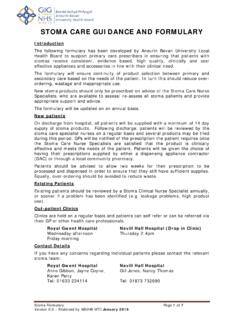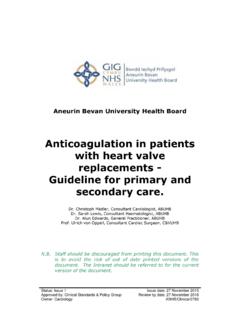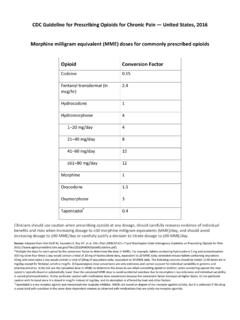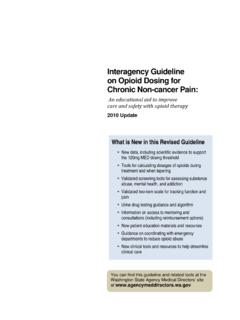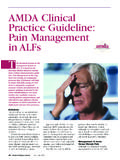Transcription of ABHB Prescribing Guideline Use of Transdermal …
1 This Guidance should be used in conjunction with the Summary of Product Characteristics (SmPC) for the particular brand of fentanyl patch being used. Adapted from Fife Guideline of April 2007 Status: APPROVED Date produced: 27 May 2011 Approved by: ABHB MTC Page 1 of 3 Review Date: May 2013 ABHB Prescribing Guideline Use of Transdermal Fentanyl Patches INDICATION FOR FENTANYL PATCHES Morphine is the first choice strong opioid for patients at the third stage of the WHO ladder Fentanyl patches should only be considered if: The oral route is unacceptable nil by mouth, gastrointestinal upset. Morphine / diamorphine cannot be tolerated due to side effects constipation, drowsiness, confusion, signs of opioid toxicity There are compliance issues supervised patch changes will assist this.
2 USE IN NON CANCER PAIN Fentanyl patches should only be used in patients with intractable pain only after all established therapies have been tried Pain Clinic advice may be needed at this point especially if the patient is < 65 yrs. Other considerations before starting strong opioids in non cancer pain: A treatment plan should be developed taking into account patient's expectations (a patient contract may be needed if there are concerns about how engaged the patient is with the treatment plan). Written information should be given to the patient to facilitate their informed consent the British Pain Society s patient information leaflet ( ): Patients with previous drug/alcohol problems or psychiatric history (major depression, psychosis, risk of suicide) should be treated with strong opioids only with great caution. Opioids should be withdrawn if the primary goal of pain relief is not achieved with a reasonable dose as this is an indication that the pain is not opioid responsive.
3 For a consensus statement on Prescribing opioids in non malignant pain see Opioids for Persistent Pain: Good Practice (Jan. 2010) at: Local guidance on the Use of Strong Opiates in Chronic Non malignant Pain is at: GwentGuidance%5 BFinal% USEFUL FACTS: Fentanyl is a strong opioid. Fentanyl is less likely to cause toxicity in renal failure than morphine. Fentanyl patches are not suitable for patients with unstable pain. It takes 6 to12 hours for the patch to begin to work and will take 36 to 48 hours to reach stable plasma levels therefore pain control may be erratic continue to use breakthrough doses as required. The patch dose can be titrated up in increments after 72 hours if pain is uncontrolled. The oral morphine equivalent to the 25micrograms/hr patch is in the range 30 to 120mg/day. Therefore fentanyl patches must be used very carefully in patients who are opioid na ve.
4 A 12 micrograms /hr patch is now available for sensitive patients and incremental dose increases. There is no ceiling to fentanyl patch dose: multiple patches can be used together. To achieve good analgesia the patch strength should be titrated up. There are two types of patch available a RESERVOIR patch where the drug is held in solution and a MATRIX patch where the drug is distributed evenly throughout a matrix. Although no evidence exists for differences in release profiles it would be prudent to ensure patients remained on the same type of patch unless problems ( poor adhesion) occur. SAFETY ISSUES WITH FENTANYL PATCHES A MHRA drug safety update (Sept. 2008) detailed fatalities from respiratory depression that occurred in patients not previously treated with strong opioids. Variation in absorption from patches can occur with changes in temperature and there is a risk of toxicity in warm weather / fever / application of a heat source Patients undergoing MRI, cardioversion or diathermy should have patch removed prior to procedure Transdermal FENTANYL IN DOSES GREATER THAN 50micrograms SHOULD NOT BE USED FOR CHRONIC NON MALIGNANT PAIN WITHOUT SPECIALIST ADVICE FROM THE PAIN CLINIC This Guidance should be used in conjunction with the Summary of Product Characteristics (SmPC) for the particular brand of fentanyl patch being used.
5 Adapted from Fife Guideline of April 2007 Status: APPROVED Date produced: 27 May 2011 Approved by: ABHB MTC Page 2 of 3 Review Date: May 2013 HOW TO START FENTANYL PATCHES Determine the appropriate fentanyl patch strength using the conversion chart on Page 3. To convert from: 4 hourly pain medication apply patch and continue with the next three doses of regular analgesia, then discontinue. 12 hourly pain medication apply patch with last dose of controlled release opioid then discontinue. Syringe driver apply patch and continue syringe driver for 6 to12 hours, then discontinue. **CAUTION LOOK OUT FOR BREAKTHROUGH PAIN AND SIGNS OF TOXICITY** **WEAK OPIATE SHOULD NOT BE CONTINUED FOLLOWING THE CONVERSION TO A STRONG OPIATE** To apply: Apply to clean, hairless skin (not exposed to radiotherapy) and hold in place for 1 minute.
6 A secondary adhesive dressing can be useful for some patients with adhesion problems. The patch works by creating a depot of drug under the skin. The patch should be replaced every 72 hours. Rotate sites. Avoid direct heat and if the patient is pyrexial, observe for opioid toxicity. Fentanyl is often less constipating than morphine. Half the dose of laxative and re titrate. Prescribe strong opioid for breakthrough with either immediate release morphine sulphate / oxycodone or strong opioid **PATIENTS / CAREGIVERS MUST BE TOLD HOW TO USE FENTANYL PATCHES** **ENSURE CORRECT BREAKTHROUGH DOSE OF STRONG OPIOID IS AVAILABLE AT ALL TIMES** (see chart on Page 3 and also Note ABHB guidance on the Use of Immediate Release (IR) Fentanyl for the management of Breakthrough Cancer Pain at: ) ADVICE FOR END OF LIFE CARE / UNSTABLE PAIN FOR PATIENTS ALREADY USING FENTANYL PATCHES If the patient is dying and/or pain control becomes unstable and additional analgesia is required, you can.
7 Leave the patch on (continuing to replace every 72 hours) and add a continuous subcutaneous infusion (of diamorphine / morphine sulphate) Diamorphine / Morphine infusion should be based on previous breakthrough requirements. If breakthrough requirement is not known, give the equivalent of 2 to 3 breakthrough doses (representing a 30 to 50% dose increase) as subcutaneous infusion over 24 hours. (see chart on Page 3). Revise the breakthrough dose to reflect both the patch and the additional regular opioid dose. Example: Patient is prescribed a 100micrograms/hr fentanyl patch and has received three breakthrough doses of s/c diamorphine 20mg over the previous 24 hours. The pain is now unstable. It would be advisable to: 1. continue the patch at the same dose (continuing to replace every 72 hours) 2. Add a continuous infusion of diamorphine at a dose of 60mg over 24 hours.
8 3. Change the breakthrough dose to 30mg diamorphine subcutaneously. TO DISCONTINUE THE FENTANYL PATCH Reasons : opioid toxicity, opioid switch, allergy, non adherence, patient choice, dose reduction After the patch is removed, a reservoir of the drug remains under the skin, and it continues to be released for approximately 17 hours (range 13 to 22 hours). For the first 12 to 24 hours breakthrough medication only should be prescribed, then a long acting alternative can be prescribed. Observe for signs of opioid toxicity during this period. For any advice or for patients needing a syringe driver rather than fentanyl patches seek advice from the specialist palliative care team. CONTACT DETAILS FOR PALLIATIVE CARE Within working hours Specialist Hospital Palliative Care Teams Royal Gwent Hospital Tel. 01633 234934 Caerphilly Miner s Hospital Tel.
9 029 20851811 Bleep 0853 Nevill Hall Hospital Tel. 01873 732777 Specialist Palliative Care Inpatient Units (including Hospices) St Anne s Hospice, Newport Tel. 01633 820317 Community Specialist Palliative Care Teams St David s Foundation Tel. 01633 271364 Hospice of the Valleys Tel. 01495 717277 Out of Hours specialist palliative care advice If a healthcare professional needs more advice or guidance outside normal working hours, please call 02920 426000 (Marie Curie Hospice, Penarth) This Guidance should be used in conjunction with the Summary of Product Characteristics (SmPC) for the particular brand of fentanyl patch being used. Adapted from Fife Guideline of April 2007 Status: APPROVED Date produced: 27 May 2011 Approved by: ABHB MTC Page 3 of 3 Review Date: May 2013 CONVERSION AND BREAKTHROUGH CHART Note that the 25micrograms/hr Fentanyl patch must be used with caution in patients who are opioid na ve.
10 The figures below are an APPROXIMATION and the patient should always be reviewed for signs of toxicity and inadequate analgesia during a conversion. When switching opioid consider whether the patient s pain is already controlled as to whether a higher dose is needed. The ranges quoted are suggested alternative doses to use (based on strengths of preparations available) & should minimise the number of tablets/caps required FENTANYL PATCH micrograms / hour EQUIVALENT ORAL MORPHINE mg in 24 hours (range) EQUIVALENT S/C DIAMORPHINE mg in 24 hours BREAKTHROUGH ORAL MORPHINE mg (range) BREAKTHROUGH ORAL OXYCODONE mg (range) BREAKTHROUGH S/C DIAMORPHINE mg 12 45 (40 to 60) 15 (5 to 10) ( to 5) 25 90 (80 to 100) 30 15 (10 to 20) (5 to 10) 5 50 180 60 30 15 10 75 270 (240 to 300) 90 45 (40 to 50) (20 to 25) 15 100 360 120 60 (50 to 60) 30 20 125 450 (440 to 460) 150 75 (60 to 80) (30 to 40) 25 150 540 (520 to 580) 180 90 (80 to 100) 45 (40 to 50) 30 175 630 (580 to 640) 210 105 (100 to 120) (50 to 60)
